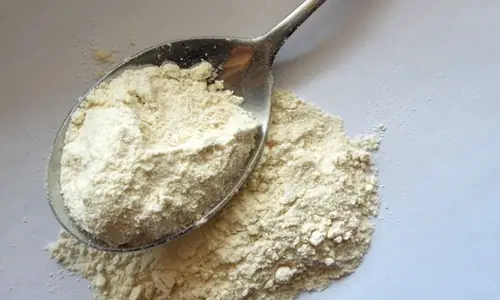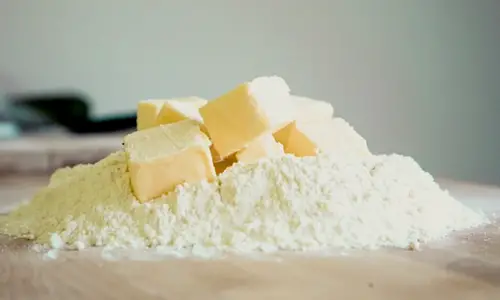
If you don’t like a thin watery soup this guide is your answer. It shares 27 ways on how to thicken any soup. It doesn’t matter whether you want to use gluten or want to be gluten-free, whether you are a meat eater, paleo or vegetarian or vegan there is a way to suit your soup thickening needs.
If you want your soups thicker this guide shows you lots of easy ways to do it. There are ways to thicken your soup with flour and ways without flour many of which are gluten-free and vegetarian.
The Ultimate Guide to Easily Thickening Soup, Try these 27 Ways to Luxuriously Thick Soup
You may want the more traditional way s to thicken your soup or you might not have or want to use cornflour or flour for different reasons.
When I started to look at alternatives to using wheat and flour in things, first as I was on a diet and then because I was experimenting with the effects of wheat on my system I had to come up with some alternatives that were easy to buy and to use.
Below are lots of methods for thickening your soup. I have included lots of different ways to do it (If you know of any methods not mentioned feel free to comment and I will add them).
Some will suit some soups rather than others or you may have particular dietary needs like gluten-free, paleo, vegetarian or vegan or low-fat eating etc. If you do not like a particular method or the taste or might not have that ingredient in your cupboard. This gives you options.
I have included them all it is up to you to experiment and decide which you like best.
If you are on a diet or need to keep your carbs low you may prefer one of the flour, cornflour and cornstarch free methods. Many diets want to reduce flour use.
Be aware that some methods leave a taste. You may want to use this to your advantage or in some cases choose something else.
Traditional Soup Thickeners & How to Use Them

How to Use Cornflour to Thicken Soup
You can use cornflour to thicken your soup by creating a slurry and adding it to your liquid (see slurry). You cannot add it directly to the mixture. Well, you can but it goes all lumpy so a slurry is the best way to introduce it and get great results. Use cornflour for more of a shiny finish.
What is the difference between Cornflour and Cornstarch?
Cornstarch is the American term for cornflour so if you see any recipes with it you can use cornflour instead.
Can You Thicken Soup With Flour?
Yes. There are several methods of soup thickening that use flour. These are easy to do but have fancy names which make them sound harder to make than they actually are in my view. They include the slurry the Roux and the Beurre Manie (which means nothing more than kneaded butter).
The Slurry
What is a slurry?
A slurry is a simply a thickener that you use to thicken soup that is made from the same amount of water and flour, or cornflour or sometimes even arrowroot. It can also be called a whitewash.
How to Make a Slurry Using Flour
The slurry is easy to make. You simply get a tablespoon of white flour and add a small amount of water, stock or even the soup liquid to it and mix it together until it has completely combined and lump free. Larger quantities of soup may require more than one tablespoon though so increase your mixture depending on your soup quantity you can always decide not to add it all.
The liquid needs to be cool as if you add the flour directly to a hot liquid it goes lumpy and will not mix in. This is why you make a slurry rather than adding the flour directly to the soup.
Now all you have to do is add it to the soup. Just add it a bit at a time and mix it in until it has completely combined with the soup. Now continue stirring until your soup is as thick as you want it to be.
What are the Healthier Options When Making a Slurry?
If you don’t want to use white four you can replace this with wholemeal flour but you may find you need to add more water to the mixture.
You can also use arrowroot to make your slurry if you want to avoid flour.
Advantages of using the Slurry are it is quick and easy to do, can be added at the end if you find your soup isn’t thick enough, it is made with flour which you are likely to have in your cupboard.
Disadvantages are because the slurry is added at the end and is uncooked you can end up with a flour taste. Make sure you use sparingly and mix in thoroughly to avoid this.
The Roux

A Roux (pronounced roo) is simply an equal amount of flour and fat mixed together. You can use butter or other types of fat as well. For example sunflower oil, vegetable oil or various animal fats.
Roux is used for thickening sauces and soups.
Roux is very flexible as you can use any fat that you want to. This means that you can simply use butter or a fat where the flavour compliments your soup.
How to Make a Roux
- Weigh out equal amounts of flour and fat
- Melt your butter in a pan
- Gradually mix in your flour until you have a smooth mixture.
- Cook for about 2o minutes until it is light golden brown.
- Add your roux to your soup at the beginning.
Tips for the Perfect Roux
- Make sure that your fat is 100% fat for the equal amounts to apply if it isn’t you will need to adjust the amount of flour you use accordingly.
- To make sure it doesn’t go lumpy you need to add in small amounts and mix in gradually.
- When you cook a roux the longer it is cooked the darker it gets. For soups, you don’t want it too dark as the darker it is the less it will thicken your soup. Each level of roux has different names. the best level for soups is the blond Roux (cook for approx 20 minutes). If you want to learn about the other uses for different levels of Roux see this article.
Perfect for
Any soups and many sauces. However, it works particularly well with soups that have cream or cheese as it helps to stop them from breaking down.
How to Make a Beurre Manie
Yeek! Sounds complicated, but thankfully it isn’t. The Beurre Manie (This is pronounced BURR mahn-YAY) simply means kneaded butter and is really easy to make and is very similar to the Roux to make only it doesn’t need to be cooked. I found this video from Noreen’s Kitchen on YouTube it explains it perfectly.
Simply Add Dumplings
Ok, not a method as such but it works a treat. If you add dumplings to stew or soup and cook them in the liquid they will also thicken it. And you get tasty dumplings as a bonus.
How to Thicken Soup? Use Gluten Free Flour
You can use a gluten-free flour to replace the Slurry and Roux in a similar fashion.
-
Five Popular Gluten-free flours That Work for Thickening Soup
- Cornflour (Made from maize)
- Coconut Flour
- Gluten-free flour i.e. all purpose gluten free flour or almond flour etc
- Cassava Flour
- Rice flour
Rice flour can be used as a slurry or a roux, Some supermarkets like Sainsbury sell it but not all. You can also get it online or in health food shops.
There are several methods of thickening soup for people that made without flour and are gluten-free. These methods are included here :
Soupologie: Plant-based, gluten-free soups to heal, cleanse and energise
How to Thicken Soup Without Flour with These 23 Easy Gluten-Free Ingredients
With the exception of Cornflour, almond flour & coconut flour all the items on the gluten-free list are also popular methods for thickening soup without flour even if you are not looking for gluten-free specifically.
- Agar Powder Great for vegetarians and Vegans
Mix a 1/2 teaspoons of Agar powder with about 250g of water/liquid. All you need to do is dissolve it by heating gently and bringing to the boil then you can add it to your soup.
Note: This may vary depending on the brand you use so check the pack instructions. Some vary greatly from this. In addition, the amount you use will vary depending on the liquid used as how it works is affected by the acidity or alkaline content of your liquid. - Amaranth Seeds
Amaranth Seeds make a great soup thickener and they are easy to use. You simply pop a couple of tablespoons, about 14g into your soup when it is cooking. It swells up and becomes gelatinous goo. Try it out before using for the family or a party though as it is not to everyone’s taste. - How to Thicken Soup With Arrowroot
Arrowroot is perfect for thickening soups. There are some things to consider when using it though. Firstly it needs to be cooked at a lower temperature than other thickeners. If you use too high a temperature or overcook it, it breaks down and doesn’t work. It is great for soups that are clear as it does not make them cloudy when it is added. However, it is not so great when you are using dairy products in your soup recipe as it makes the soup go all slimy. A good way to use it when you are thickening your soup is to remove your soup from the heat and let it cool and then add it.
You can also make a slurry from it and add that at the end of the cooking time. - Chia Seeds
Chia seeds are great to add to soup to thicken it as they are really healthy and they don’t change the taste of your soup. All you need to do is to soak them overnight or four a couple of hours in boiled water and add them to your soup. You don’t need many as they swell up to up to 10 times their size. A tablespoon or so will do it, simply pop them into your soup and stir in.
Warning: Never eat dried chia seeds as they swell up in your mouth and can be a choking hazard. - Coconut Milk
Coconut milk is great to add to your soup if you want it to be creamier. It is perfect if you want to be dairy free. All you do is add about 60ml to your soup and stir it in. It does add a slight coconut flavour to your soup but it isn’t too strong. - Couscous
Add small amounts of couscous to your soup to thicken it and allow it to cook for a few minutes. - Dairy – Cream, Milk, and Yoghurt
When you use cream, milk & yoghurt to thicken and add creaminess to your soup you need to temper it first to help prevent it from curdling. To do this you need to add some of the soup to the cream and mix it in before you add it to the soup. This warms it up and prepares it for putting into the soup. Remove your soup from the heat then add your tempered cream then return your soup to the hob and gently heat it up again.
It is also a good idea to buy full-fat versions as they work better. - Eggs
There are lots of ways to add eggs to soups in order to thicken them. Soup recipes will ask for eggs to be added sometimes. You can use the yolk, the white and sometimes both. Eggs are also often mixed with different things like cream when used as a thickener - Gelatin
Gelatin is perfect for thickening soup because it works well and is both gluten-free and also low in carbs. When you use gelatin it gives your soup a silky feel to it. A word of warning though don’t use too much or you will find yourself with a near solid soup lol. You can find more details about gelatin and how to use it here. - Kudzu Root Starch Powder
Kudzu is perfect for thickening soups and sauces. It gives you a thick yet clear shiny finish and it doesn’t alter the taste of your soup. You use it the same as you would Arrowroot. It is easy to use and is perfect for vegans. On the downside, though it is a bit on the expensive side and you may not be able to get it in your local supermarket.
“Kudzu” or Kuzu or Japanese Arrowroot is a tuber from Japan. - Lentils
Lentils are good at thinking soup and they are healthy and vegetarian too. They are high in protein.
Simply add a tablespoon or two to your soup at the beginning depending on how thick you want it. Make sure you cook your soup long enough for the lentils to soften. It is surprising how much difference they make. You can use them in any soup but they work really well in soups you intend to blitz. Green lentils are popular for this but you can use other lentils - Nuts**
You can use any of the main types of nuts like brazils, almonds, hazelnuts or cashews etc. Grind your nuts down and add them to the soup. Wikihow has instructions that cover this beautifully.
**Remeber to take into account any nut allergies people might have. - Oatmeal
Simply use oatmeal or grind down quick rolled oats in your food processor and add it to your soup. You will only need a small amount, about 7g should do it, if not add a little more ground oats later.
(Just check it is pure and nothing has been sneaked in as not all oatmeal is pure these days) - Pectin
Pectin binds with sugar to create a thickener, it is traditionally used in jam making. However, you can also use it to thicken the soup. You need to be very careful though as you only need a little bit or you will end up with a soup lollypop! It can only be used with soups that contain sugar due to its binding properties. There are pectins you can use without sugar. You need 0.5g of pectin to 250g liquid. - Potatoes & Sweet Potatoes Make for an Easy Soup Thickener
This is a favourite for dieters who are trying to avoid flour. This is one of my favourite methods as it is easy to do and doesn’t create any more dishes. There are several ways to do this- You can use fresh potatoes
- Potato flakes
- Instant (or pre-created) mash
- You can also buy potato starch in health food shops. Potato starch is great because you can add it to the end of your cooking time if you need instant thickness.
- Puree Soup
Remove some of your soup from your pan and put it into another bowl and use a soup whisk to puree it then stir it back into your soup to thicken it up. - Allow your soup to Reduce Down
A simple way to get your soup to thicken up is to simply allow it to reduce down and as the liquid evaporates it becomes thicker. - Rice Grains
Use Rice Grains When you are going to Puree the Soup
Simply add rice to your soup and cook. This is ideal to use if you are going to puree the soup as the rice makes it thick and creamy. - Tapioca Starch
Tapioca comes from the root of the cassava (Manihot esculenta). It is a native American perennial plant that has many uses. It makes a great thickener and the results are clearer than cornflour. It does not separate when you freeze it because it holds the water. The best way to use it is like cornflour as a slurry (see above) where you simply mix it with water before adding it to your soup. - Tomato Puree
Can be added to tomato-based soups or soups where the puree would compliment it to add some thickness. However, it can change the taste of fresh tomatoes so ideally only add small amounts. - Water Chestnut Starch
This can be used to replace cornflour as a thickener. - White Butter Beans
White butter beans are great for thickening soups as they don’t change the taste of the soup. There are two ways you can add them to your soup to thicken it.- If you intend to blend your soup you can simply add them and blend your soup as normal
- If you are not blending the soup cook them separately and blend them and then add them to your soup.
- Xanthan Gum
Xanthan Gum is fantastic to add to soups as it is really easy to use and it doesn’t affect the taste like that. It can easily be dissolved in liquid at any temperature so you don’t have to worry when adding it to a soup that you are going to get lumps etc. All you need to do is mix in with sugar into some water, ideally warm and then add it to your soup. It is very cost efficient as you only need a very small amount. You need 0.5g of pectin to 250g of water. You can get it at the supermarkets, health shops and online.
Disclaimer: Always double check the packet and contents before purchase just in case some gluten has been added.
How to make a Liaison
A Liasion is simply a binding agent although it is more often than not used to indicate a mixture of egg yolks and cream which is used to thicken soups (and also sauces). This is mixed together in varying ratios depending on how thick you want your soup. It only thickens slightly but it has a lovely smooth texture and look to it. As a general guide, you will need a 1:3 or 1:3 ratio of egg yolks to cream
- Beat the cream and the egg yolks together until they are thoroughly mixed.
- Now temper your mixture. This is simply adding some of your hot soup (liquid only) to your mixture. Do this gradually so as not to mess up your mixture.
- Now remove your soup from the heat and gradually mix in your liaison into your soup.
- Gently reheat your soup, however, make sure you do not allow to boil under any circumstances or your soup will curdle.
Warning: Please note that because there are eggs included it is best to use this soup straight away and not to pop it in the fridge.
How to Substitute Flour in Your Recipes
If you are following a recipe and are substituting a different thickener you may need to use a different amount than suggested in the recipe.
For flour to gluten-free flour, you can mostly use a 1:1ratio
.However for other things, you may want to alter your quantities.
Not everyone will be happy with large amounts of flour in their soup for various reasons. It could be that they are on a diet and not allowed to use it or much of it, don’t like the taste etc, In this case, perhaps choose two ingredients/methods and reduce the total flour/GF flour in the soup.
How to Thicken Soup in a Slow Cooker or Crockpot
I like to add dumplings if I am cooking a stew in my slow cooker as there is nothing like that thick stogy mix to remind you of mums homecooked stews. In my cooker, you can add them 1/2 hour before the end of cooking. However, they are not always suitable and you can use many of the other methods described here.
You don’t want to be adding things during cooking as this adds to the overall cooking time. So you need to either add something at the start or in the last 1/2 hour of cooking. You can use a slurry at the end to thicken your soup.
You can also use lentils, seeds etc. You have to be careful not to use too many as you don’t want them to take all the water and leave your soup dry.
How to Thicken Soup in a Soup Maker
If you are using your soup maker to create your soup and want to thicken it there are some things you can do. If your soup maker says that you cannot open the lid during soup making then some of the methods above that require you to add something part of the way through would not be suitable. However, any of the methods that you can include at the beginning of the process will work. For example, adding potatoes, lentils or chia seeds.
Warning: Although anything that swells up a lot like chia seeds and absorbs all the liquid should be used with caution you don’t want your soup dried out or burning your machine.
How to Thicken Soup After it is Made
If you find that your soup is not thick enough at the end of cooking there are several things you can do to make it thicker.
- You can add a flour-based slurry to it. This is simply flour and water or stock. See the flour section above for full instructions.
- You can also make a slurry from Arrowroot in a similar fashion
- Potato starch can be added at the end.
- You can use Xanthan Gum
If like me you use too much water these will absorb it.
How Did You Get On With These Methods?
So now you have lots of ways that you can pick to thicken your soup. Each one has different properties. some change the taste others do not, some thicken better than others, some make your soup silky smooth. Which methods do you think you will like best and why?
For me, I like things to be quick and easy to make and that doesn’t alter the taste that makes the soup really thick. It shouldn’t add too much to the cost either as soup should be a hearty but economical meal.
Which ones do you like the best? We’d love to hear your views on how you get on with these techniques. Are there any that you think are a pain or ones that you have tired and found you liked better than expected?
Other readers would love to hear your views.



